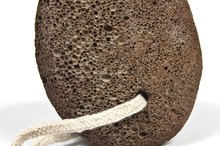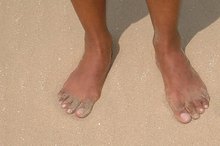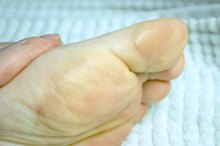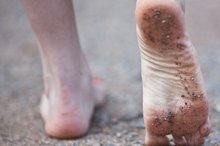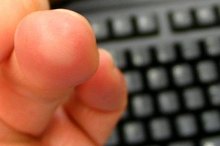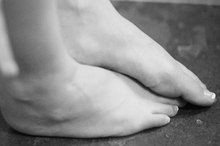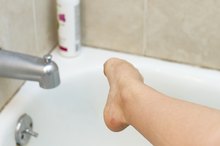How to Remove Hard Skin From Feet
Pressure and friction cause the skin on your feet to thicken and harden as a protective measure. The result is rough skin, corns and calluses 23. While removal of hard skin is rarely medically necessary, treatment may be desired to ease discomfort or improve appearance. Do not attempt to treat hard skin, corns or calluses at home if you suffer from diabetes or problems with sensation or circulation in your feet, which can lead to dangerous infections.
Soak your feet in warm water to soften hard skin and make removal easier. Avoid using harsh soaps when washing or soaking your feet, as soap removes your skin's natural oils, thereby increasing dry skin and making corns and calluses worse.
How to Treat Cracked Diabetic Feet
Learn More
Rub hard areas with a pumice stone to remove the top layer of thickened skin. Be careful not to rub the stone across soft, live skin, as doing so can cause pain and tissue damage.
Rinse the pumice stone during use to wash away dead skin and debris. This will make removing hardened areas on your feet easier and will prolong the life of your stone.
Cracked Bleeding Feet
Learn More
Apply moisturizing lotion to your feet within three minutes of stepping out of the water. Oil-based ointments work better at trapping moisture inside the skin than water-based lotions, according to the University of Iowa. Do not apply moisturizer between your toes, as doing so increases your risk of bacterial and fungal infections.
Cover hardened areas with petroleum jelly and cover with socks before going to bed at night. As you sleep, the petroleum will soften hard areas and ease dryness. Wash your feet when you wake up with warm water and mild soap.
Visit your doctor to have areas of hard skin cut away. This procedure is called debridement and is typically performed on an outpatient basis. Your doctor may advise you to wear cushions inside your shoes until healing is complete. The New York Times Health Guide warns against cutting away hard skin at home 3.
Wear well-fitting shoes to encourage healing and prevent calluses from returning. Also, treat any foot or toe deformities that may be contributing to hard skin on your feet. In severe cases, a special insert called a functional orthotic can help relieve pressure. Surgery may be necessary to treat underlying structural problems.
Related Articles
References
- ePodiatry: Foot Corns and Callus (Hyperkeratosis)
- Nemours Foundation: Blisters, Calluses and Corns
- New York Times Health Guide: Corns and Calluses
- American Academy of Orthopaedic Surgeons: Corns
- DeLauro T and DeLauro M (2012) Chapter 98: Corns and Calluses. Fitzpatrick's Dermatology in General Medicine (8th Edition). New York, New York: McGraw-Hill Education. ISBN-13: 978-0071669047.
- American Academy of Dermatology Association. How to treat corns and calluses. 2019.
- Reddy P, Anusha T, Haritha N, Nagendra A, Bhavani D, Gandhimathi R. Case report on non-surgical treatment for foot corn. International Journal of Dermatopathology and Surgery. 2018;4(1).
- American Academy of Dermatology Association. How to Treat Corns and Calluses. 2019.
- DeLauro T and DeLauro M (2012) Chapter 98: Corns and Calluses. Fitzpatrick's Dermatology in General Medicine (8th Edition). New York, New York: McGraw-Hill Education. ISBN-13: 978-0071669047.
Writer Bio
Sandra Ketcham has nearly two decades of experience writing and editing for major websites and magazines. Her work appears in numerous web and print publications, including "The Atlanta Journal-Constitution," "The Tampa Bay Times," Visit Florida, "USA Today," AOL's Gadling and "Kraze Magazine."
